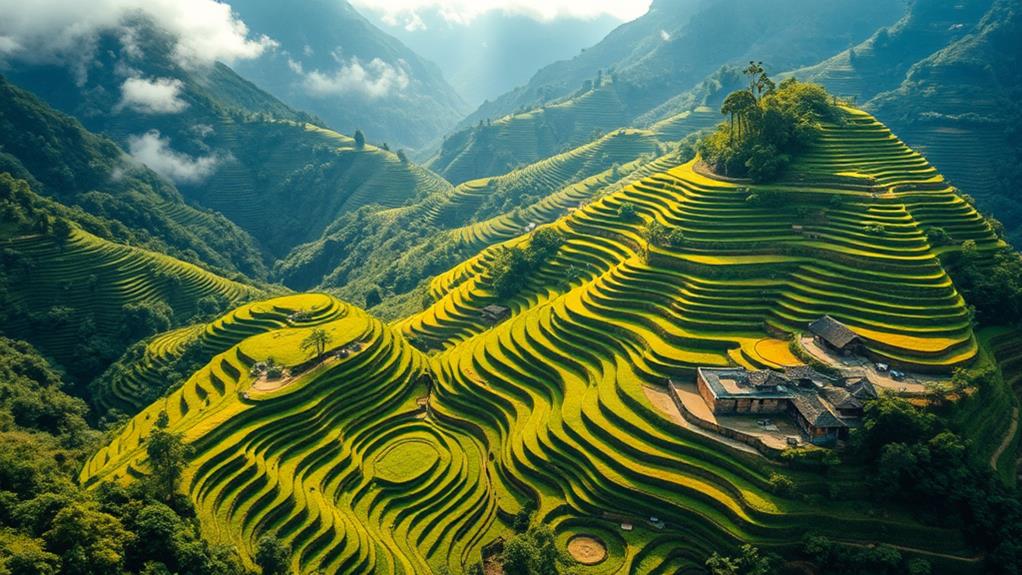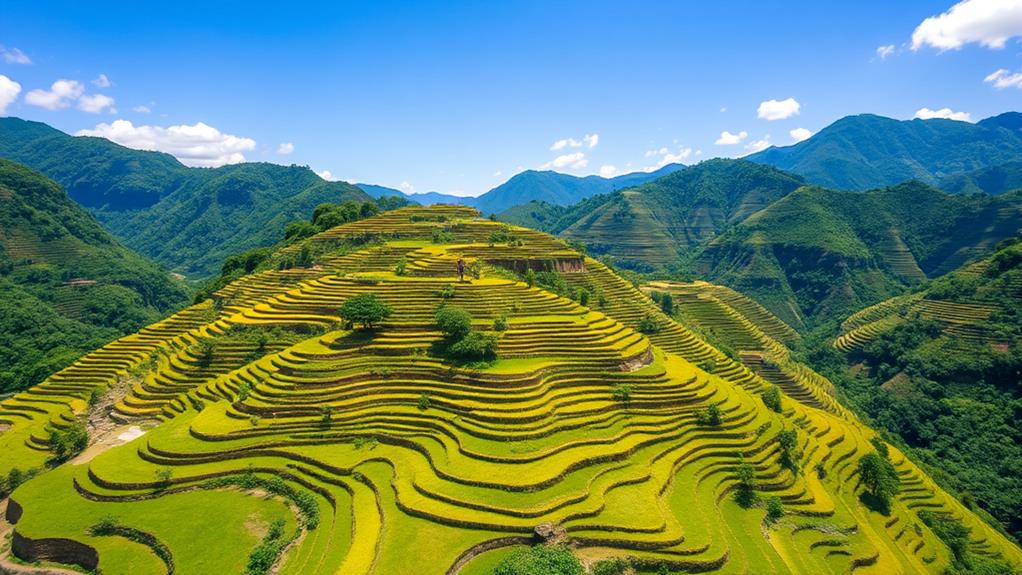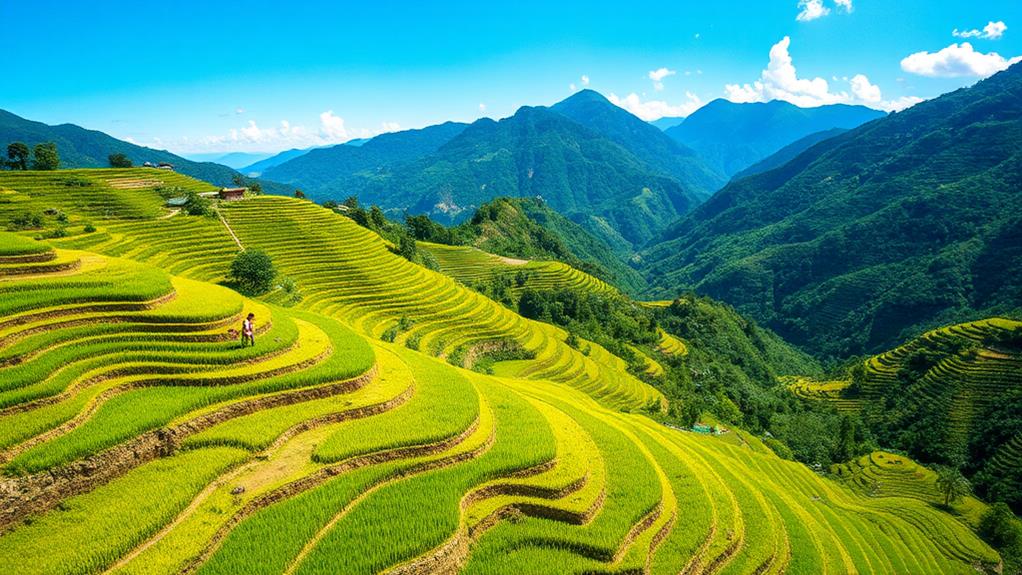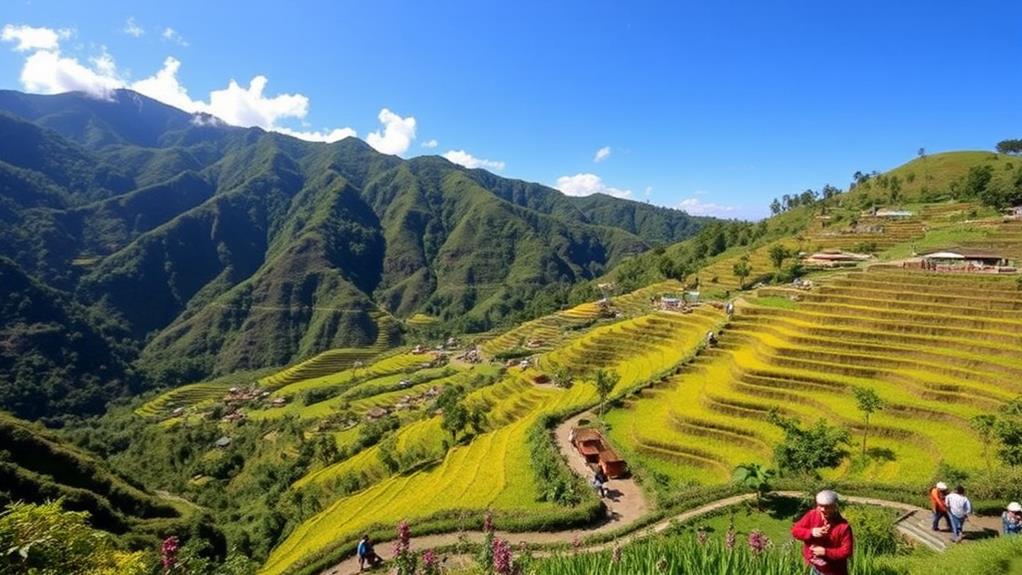The Banaue Rice Terraces: A Traditional Agricultural System and Ecosystem
The Banaue Rice Terraces, built over 2,000 years ago by the Ifugao people, showcase a remarkable traditional agricultural system that harmoniously coexists with a diverse ecosystem.
These terraced fields optimize land and water use by being built on mountain contours, fostering biodiversity through varied crops. For instance, the terraces are designed to catch and conserve rainwater, which is then channeled to support the growth of crops like rice, vegetables, and fruits.
Rice farming holds significant cultural importance, symbolizing community and ancestral ties. In Ifugao culture, rice is not just a staple food but also a symbol of prosperity, fertility, and abundance.
The terraces are a testament to the community's ingenuity and cooperation, as they require collective effort and shared knowledge to maintain.
However, the Banaue Rice Terraces face challenges that threaten their sustainability, including climate change, which alters rainfall patterns and temperature, affecting crop yields, and urban migration, which leads to a decline in the number of farmers and traditional knowledge holders.
Understanding these dynamics highlights the terraces' vital role in local and global ecology.
Overview of the Rice Terraces

The Banaue Rice Terraces are an engineering marvel that showcases the ingenuity of Ifugao agricultural practices. These terraces, cultivated for over 2,000 years, demonstrate a sophisticated understanding of land and water management.
Built along the natural contours of the mountains, they exemplify an impressive feat that enhances both beauty and productivity in this challenging landscape.
The original construction employed stone and mud walls to create a complex irrigation system. This system floods the terraces, essential for rice cultivation. The method of water management ensures that each level receives the necessary hydration, demonstrating the Ifugao people's deep connection to their environment and their ability to adapt to it.
The extensive length of the rice terraces is astounding, spanning over 10,360 square kilometers. If laid end to end, they could encircle half of the globe, emphasizing their scale and significance.
The terraces symbolize community cooperation, where collective efforts yield a bountiful harvest. This intricate system continues to be vital for sustaining the Ifugao way of life, showcasing the meticulous balance between culture and nature inherent in the Banaue Rice Terraces.
Cultural Significance
The Banaue Rice Terraces hold immense cultural significance for the Ifugao people, extending beyond agriculture to represent the essence of their identity, history, and values.
Economic Importance: Rice is a prestige crop that sustains the Ifugao economy and community life. It serves as a primary source of income and is used to pay tribute to leaders, settle disputes, and buy goods.
The terraces have fostered Social Cohesion within the community for centuries. Cultural celebrations and thanksgiving feasts tied to rice harvesting reinforce community bonds, creating a sense of belonging and shared heritage.
For example, the Ifugao people celebrate the "Tinawon Festival" to give thanks for a bountiful harvest, strengthening social ties and community spirit.
The Ifugao people have a deep Spiritual Connection to rice cultivation, which is intertwined with their religious beliefs. They believe that ancestral deities and spirits influence the success of their crops, and therefore, they perform agricultural rituals to honor these deities.
This spiritual connection emphasizes the sacred role of rice in their lives.
The 2,000-year-old terraces showcase the resourcefulness and ingenuity of the Ifugao people in adapting to their mountainous landscape.
However, the cultural significance of rice and the terraces is threatened by urban migration and changing economic interests among the younger generations.
Preserving this cultural heritage is crucial for maintaining the Ifugao identity for future generations.
Agricultural Practices

The Ifugao people's agricultural practices in the Cordillera mountains demonstrate a deep understanding of their environment and a commitment to sustainability. For over 2,000 years, they've cultivated rice on terraced fields, showcasing ancient engineering skills.
These terraces, with their steeply contoured stone walls, optimize land use and channel water resources from nearby rainforests, essential for flooded rice cultivation.
Rice is a prestige crop in Ifugao culture, symbolizing status and prosperity. However, the community also relies on sweet potatoes and various root crops as staples for its poorer members.
This diverse agricultural system promotes heterogeneous biodiversity, which is crucial for resilience against pests and climate variability.
The integration of traditional practices and indigenous knowledge is vital for maintaining the terraces and their intricate water management systems. By valuing these methods, the Ifugao people ensure that their agricultural practices remain sustainable, fostering a symbiotic relationship with the ecosystem that has supported them for generations.
Historical Context
The Banaue Rice Terraces have stood for over two millennia as a testament to the ingenuity of the Ifugao people, who transformed the rugged landscape of northern Luzon into a thriving agricultural hub.
Sophisticated Irrigation Systems: The Ifugao people built intricate irrigation systems that ensured a sustainable water supply from nearby rainforests, which was crucial for their rice cultivation.
These systems allowed them to farm the land efficiently and effectively.
The Banaue Rice Terraces are a UNESCO World Heritage Site, recognized for their cultural importance. They symbolize the rich heritage of the Ifugao people and their indigenous rice terracing methods, showcasing their unique agricultural practices.
Cultural Significance: The terraces are deeply woven into the social fabric of Ifugao life, influencing rituals, communal gatherings, and economic stability.
For example, the terraces played a significant role in the community's economic stability, as they provided a reliable source of food and income.
Historically, the Ifugao Rice Terraces sustained local populations, peaking at nearly 70,000 in 1939.
Agricultural Practices Shaped the Economy: The Ifugao people's agricultural practices not only shaped the economy but also established social dynamics within the community.
They exemplify how indigenous peoples ingeniously managed their ecosystems and resources, highlighting the deep connection between culture and agriculture.
Biodiversity and Ecosystem

Biodiversity Flourishes in the Banaue Rice Terraces
The Banaue Rice Terraces showcase a remarkable balance between agriculture and nature, where heterogeneous crops such as numerous rice varieties, root crops, nut palms, and fruit trees thrive. This diversity supports not only agricultural productivity but also fosters vibrant ecosystems. The terraces are also home to a rich variety of flora and fauna, with native species thriving in the diverse landscape created by the terraces. Moreover, the terraces are a testament to the ingenuity and resourcefulness of the indigenous people who constructed them, utilizing traditional and sustainable farming methods that have been passed down through generations. Visitors to the area can experience the beauty of the terraces while enjoying sweet mangoes from Guimaras, a nearby province known for its delectable fruit.
Tree Species and Wildlife
The surrounding forest inlands are home to over 264 tree species, which enhance the region's biodiversity.
The terraces also support a variety of wildlife, including fish, insects, and amphibians, which flourish in the unique ecosystem shaped by terraced farming practices.
Sustainable Agricultural Techniques
Regulated harvesting and sylvicultural approaches are crucial for preserving biodiversity in the Banaue Rice Terraces.
By practicing these sustainable methods, the intricate balance between agriculture and the natural environment remains intact.
Traditional Ecological Knowledge
Traditional ecological knowledge plays a vital role in managing and conserving natural resources within this system.
The integration of culture and ecology sustains biodiversity and enriches the ecosystem of the Banaue Rice Terraces, demonstrating the synergy between human ingenuity and the natural world.
Current Challenges
The Banaue Rice Terraces face significant threats to their sustainability amidst their breathtaking beauty. Approximately 25-30% of the terraces have been abandoned, leading to the deterioration of their irrigation systems, which are crucial for water management. This decline not only jeopardizes crop yields but also the traditional practices that local communities have cherished for generations.
Youth migration is a significant challenge, as younger generations move to urban areas, taking with them invaluable agricultural knowledge and skills. This loss of expertise hinders the terraces' ability to adapt to changing environmental conditions.
Climate impacts are affecting weather patterns, leading to unpredictable rain and drought, which directly influence farming productivity. For instance, droughts can reduce crop yields, while excessive rainfall can lead to soil erosion.
Sustainable tourism is a delicate balance, as it can provide economic benefits to local communities, but if not carefully planned, it can overburden the fragile ecosystem. Implementing sustainable tourism practices requires careful consideration to ensure that it benefits local communities without harming the environment.
These challenges emphasize the urgent need for a collaborative approach to preserve the rice terraces. Without addressing these issues, the unique agricultural heritage of the Banaue Rice Terraces may continue to fade, along with the culture that sustains it.
Economic Factors

The economic landscape surrounding the Banaue Rice Terraces is shaped by a complex interplay of traditional practices and modern challenges. The Ifugao province, where these terraces are located, ranks as the fourth poorest in the Philippines, reflecting the economic burdens that local communities reliant on rice production face.
Rice production is critical for local self-sufficiency, with approximately 2.5 tons of Tinawon rice exported annually. However, the sustainability of this agricultural practice is threatened by urban migration and declining interest in traditional farming. This is evident in the fact that younger generations are seeking employment opportunities in urban areas, further straining traditional agricultural practices.
The tourism industry is a significant economic activity in the local economy, driven by the allure of the rice terraces. However, recent declines in domestic tourism have raised concerns about its long-term viability.
Economic diversification is necessary for sustainable livelihoods, as the local economy can't rely solely on tourism and rice production.
Urban migration depletes the traditional farming workforce, leading to a shortage of skilled laborers to maintain the rice terraces. This, in turn, threatens poverty alleviation efforts, as the deterioration of the terraces can exacerbate poverty in the region.
Addressing these economic factors is vital for the future of both the rice terraces and the local economy.
Tourism Opportunities
The Banaue Rice Terraces offer a unique opportunity for tourism that extends beyond mere sightseeing.
These terraces represent a living culture and an ancient agricultural system recognized as a UNESCO World Heritage Site. Exploring this area provides insights into traditional practices and local lifestyles.
Guided Cultural Tours allow visitors to engage with local guides who share stories about Ifugao culture, traditional farming methods, and the historical significance of the rice terraces.
For instance, guides explain the importance of traditional farming practices, such as crop rotation and organic farming, which have been passed down through generations.
Hiking Adventures offer breathtaking vistas and immersive encounters with nature by hiking through the terraces and surrounding landscapes.
For example, the 3-day hike to the top of the terraces provides a panoramic view of the surrounding mountains and valleys.
Community Interaction enables visitors to participate in cultural activities and festivals, providing a deeper understanding of local traditions and the community's commitment to preserving this heritage.
For instance, visitors can participate in traditional dances, such as the "Tinikling," and learn about the significance of the "Hudhud" chant.
The tourism industry significantly impacts the local economy, ensuring the preservation and maintenance of these stunning rice terraces while providing enriching experiences for visitors.
Conservation Efforts

Conservation of the Banaue Rice Terraces
The conservation of the Banaue Rice Terraces relies heavily on the collaboration between local government, NGOs, and community members.
Designated as a UNESCO World Heritage Site in Danger in 2001, the terraces were removed from the list in 2012 due to conservation efforts. However, continued initiatives are essential to combat ongoing challenges like soil erosion, deforestation, and water management.
Community Involvement
Community involvement is at the heart of these initiatives.
Local residents are actively engaged in educational programs that raise awareness of the terraces' cultural heritage and promote eco-tourism, creating a sustainable funding source for conservation projects.
Conservation Strategies
Four key strategies are employed to conserve the Banaue Rice Terraces:
Community-Based Approaches: Integrate indigenous knowledge with modern techniques to conserve the terraces.
Educational Programs: Promote cultural heritage and eco-tourism to create a sustainable funding source for conservation projects.
Environmental Initiatives: Address soil erosion, deforestation, and water management to preserve the terraces.
Collaboration: Foster partnerships among local government, NGOs, and residents to ensure the success of conservation efforts.
Travel Tips and Access
Traveling to the Banaue Rice Terraces is an adventure filled with stunning views and cultural insights. Located about 216 miles (348 km) from Manila, the journey takes around 8-10 hours by bus, offering a scenic ride through mountainous landscapes.
Plan Your Visit: The best time to visit the Banaue Rice Terraces is during the winter months (December to February) for reliable weather. If you want to see the vibrant golden landscapes, visit in June during the harvest season.
Getting There: Daily bus services are available from Manila to Banaue. Check the schedules to find the best options for your trip.
Maximize Your Experience: Consider joining guided tours to gain a deeper understanding of the local culture and agricultural practices related to the terraces.
Questions and Answers
What Is Special About Banaue Rice Terraces?
The Banaue Rice Terraces hold significant cultural importance as they reflect the rich heritage of the Ifugao people. This is evident in their ingenious agricultural innovation, which involves an ancient irrigation system that demonstrates sustainable farming practices.
For instance, the terraces utilize a complex network of canals, dams, and sluices to distribute water efficiently, allowing for multiple harvests per year.
The terraces promote ecological diversity by providing a habitat for various plant and animal species unique to the region.
This biodiversity is crucial as it supports the local ecosystem and ensures the long-term sustainability of the farming system.
The terraces aren't just a farming method but a vital part of the community's identity, as they've been an integral part of the Ifugao people's way of life for over 2,000 years.
Why Are the Banaue Rice Terraces Considered a Famous Attraction and a UNESCO World Heritage Site in the Philippines?
The Banaue Rice Terraces are a famous attraction and UNESCO World Heritage Site in the Philippines due to their rich cultural heritage and stunning landscapes.
These terraces showcase sustainable agriculture and indigenous practices that have been in place for centuries, reflecting the deep connection between the Ifugao people and their environment.
The Ifugao people's intricate understanding of agriculture is demonstrated through the terraces' unique architecture, which has been preserved through ongoing efforts to maintain this remarkable cultural site for future generations.
What Is the Ifugao Farming System?
The Ifugao farming system is a 2,000-year-old sustainable agricultural practice that showcases the Ifugao people's traditions.
This system is characterized by an intricate network of rice terraces that demonstrate community involvement in planting and harvesting, fostering social bonds among farmers.
The Ifugao farmers utilize ancient irrigation techniques to cultivate rice alongside diverse crops, ensuring resilience and food security.
For instance, they plant rice with other crops like vegetables and fruits, which helps to maintain soil fertility and reduce pests and diseases.
This farming system not only nurtures the land but also preserves a rich cultural heritage, deeply rooted in communal cooperation.
How Does Climate Change Affect Banaue Rice Terraces?
Climate change poses a significant threat to the Banaue Rice Terraces. The terraces, which have been in use for over 2,000 years, are facing new challenges due to changes in weather patterns.
Increased rainfall intensity and prolonged dry seasons are altering the water supply and putting the stability of the terraces at risk.
To mitigate these effects, effective water management strategies are crucial. This includes implementing systems to collect and store rainwater during heavy rainfall events, as well as developing irrigation systems that can efficiently distribute water during dry periods.
Crop diversity is also essential for enhancing resilience. By planting a variety of crops, farmers can reduce their dependence on a single crop and increase their chances of having a successful harvest, even in the face of changing weather patterns.
For example, planting drought-resistant crops during dry seasons can help farmers adapt to shifting climatic conditions.
By focusing on these elements, the sustainability of the Banaue Rice Terraces can be maintained. This unique agricultural system, which isn't only a source of food but also a cultural heritage site, can continue to thrive despite the challenges posed by climate change.